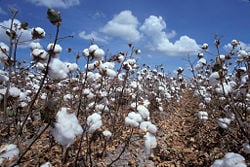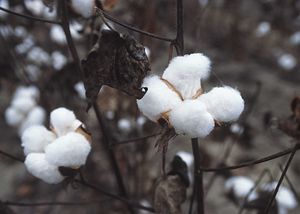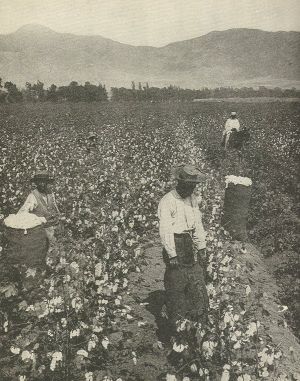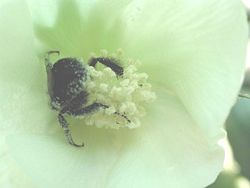Difference between revisions of "Cotton" - New World Encyclopedia
| Line 1: | Line 1: | ||
{{Contracted}} | {{Contracted}} | ||
| + | |||
| + | {{Taxobox_begin | color = lightgreen | name = ''Gossypium''}} | ||
| + | {{Taxobox_image | image = [[Image:Feld mit reifer Baumwolle.jpeg|250px]]| caption =''Ripening commercial cotton bolls in the field''}} | ||
| + | {{Taxobox_begin_placement | color = lightgreen}} | ||
| + | {{Taxobox_regnum_entry | taxon = [[Plant]]ae}} | ||
| + | {{Taxobox_divisio_entry | taxon = [[Flowering plant|Magnoliophyta]]}} | ||
| + | {{Taxobox_classis_entry | taxon = [[Magnoliopsida]]}} | ||
| + | {{Taxobox_ordo_entry | taxon = [[Malvales]]}} | ||
| + | {{Taxobox_familia_entry | taxon = [[Malvaceae]]}} | ||
| + | {{Taxobox genus entry | taxon = '''''Gossypium'''''}}<br/>{{Taxobox authority new | authority = [[Carolus Linnaeus|L.]]}} | ||
| + | {{Taxobox_end_placement}} | ||
| + | {{Taxobox_section_subdivision | color = lightgreen | plural_taxon = Species}} | ||
| + | ''See text'' | ||
| + | {{Taxobox_end}} | ||
| + | |||
[[Image:CottonPlant.JPG|thumb|300px|Cotton ready for harvest. Photo courtesy of USDA Natural Resources Conservation Service.]] | [[Image:CottonPlant.JPG|thumb|300px|Cotton ready for harvest. Photo courtesy of USDA Natural Resources Conservation Service.]] | ||
| Line 12: | Line 27: | ||
==Cotton plants== | ==Cotton plants== | ||
==Cotton fiber== | ==Cotton fiber== | ||
| − | |||
==History== | ==History== | ||
| + | [[Image:Boll weevil.jpg|thumb|Boll Weevil, ''Anthonomus grandis'']] | ||
| + | |||
==Present status== | ==Present status== | ||
| Line 20: | Line 36: | ||
==Cotton plant== | ==Cotton plant== | ||
| − | |||
| − | |||
| − | |||
| − | |||
| − | |||
| − | |||
| − | |||
| − | |||
| − | |||
| − | |||
| − | |||
| − | |||
| − | |||
| Line 50: | Line 53: | ||
* ''[[Gossypium thurberi]]'' Tod. – Arizona wild cotton, native to [[Arizona]], [[New Mexico]] and northern [[Mexico]]. | * ''[[Gossypium thurberi]]'' Tod. – Arizona wild cotton, native to [[Arizona]], [[New Mexico]] and northern [[Mexico]]. | ||
* ''[[Gossypium tomentosum]]'' [[Thomas Nuttall|Nutt.]] ex Seem – ''Ma‘o'' or Hawaiian cotton, is a species endemic to the [[Hawaiian Islands]]. The seed hairs (lint) are short and reddish brown, unsuitable for spinning or twisting into thread. | * ''[[Gossypium tomentosum]]'' [[Thomas Nuttall|Nutt.]] ex Seem – ''Ma‘o'' or Hawaiian cotton, is a species endemic to the [[Hawaiian Islands]]. The seed hairs (lint) are short and reddish brown, unsuitable for spinning or twisting into thread. | ||
| − | + | ||
| − | [[Image:Prokudin-Gorskii-47.jpg|thumb|right|250px|Cotton field in | + | [[Image:Prokudin-Gorskii-47.jpg|thumb|right|250px|Cotton field in Sukhum Botanical Garden, photo ''ca.'' 1912]] |
<br clear=all /> | <br clear=all /> | ||
Revision as of 04:07, 20 September 2006
| Gossypium | ||||||||||||
|---|---|---|---|---|---|---|---|---|---|---|---|---|
 Ripening commercial cotton bolls in the field | ||||||||||||
| Scientific classification | ||||||||||||
| ||||||||||||
| Species | ||||||||||||
|
See text |
Cotton is a soft fiber that grows around the seeds of the cotton plant (Gossypium spp.), a shrub native to the tropical and subtropical regions of both the Old World and the New World. The fiber is most often spun into thread and used to make a soft, breathable textile, which is the most widely used natural-fiber cloth in clothing today. The English name descends from the Arabic word al qutun, (whence also came the Spanish word algodón) meaning cotton fiber.
Cotton fiber (once processed to remove seeds and traces of wax, protein, etc.) consists of nearly pure cellulose, a natural polymer. Cotton production is very efficient, in the sense that, ten percent or less of the weight is lost in subsequent processing to convert the raw cotton bolls into pure fiber. The cellulose is arranged in a way that gives cotton fibers a high degree of strength, durability, and absorbency. Each fibre is made up of twenty to thirty layers of cellulose coiled in a neat series of natural springs. When the cotton boll (seed case) is opened the fibres dry into flat, twisted, ribbon-like shapes and become kinked together and interlocked. This interlocked form is ideal for spinning into a fine yarn.
Cotton plants
Cotton fiber
History
Present status
Cultivation
Successful cultivation of cotton requires a long growing season, plenty of sunshine and water during the period of growth, and dry weather for harvest. In general, these conditions are met within tropical and warm subtropical latitudes in the Northern and Southern hemispheres. Production of the crop for a given year usually starts soon after harvesting the preceding autumn. Planting time in spring varies from the beginning of February to the beginning of June.
Cotton plant
Gossypium is a genus of 39-40 species of shrubs in the family Malvaceae, native to the tropical and subtropical regions of both the Old World and the New World. The cotton plants, sources of commercial cotton fabric, are included in this genus.
Cotton shrubs can grow up to 3 m (10 ft) high. The leaves are broad and lobed, with three to five (or rarely seven) lobes. The seeds are contained in a capsule called a boll, each seed surrounded by downy fibers called lint. Commercial species of cotton plant are G. hirsutum (U.S. and Australia), G. arboreum and G. herbaceum (Asia), and G. barbadense (Egypt). While the lint naturally occurs in colors of white, brown, and green, fears of contaminating the genetics of white cotton has led many cotton-growing locations to ban growing of colored cotton varieties.
Species of Gossypium
- Commercial cotton species
Commercial cotton fibers, used to manufacture cloth, are derived from the fruit of the cotton plant. The following species are grown commercially:
- Gossypium arboreum L. – Tree cotton, native to southern Asia.
- Gossypium barbadense L. – Creole cotton or Sea island cotton, native to tropical South America.
- Gossypium herbaceum L. – Levant cotton, native to southern Africa
- Gossypium hirsutum L. – Upland cotton, native to Central America, the Caribbean and southern Florida.
- Non-commercial species
- Gossypium sturtianum J.H. Willis – Sturt's Desert Rose, native to Australia.
- Gossypium thurberi Tod. – Arizona wild cotton, native to Arizona, New Mexico and northern Mexico.
- Gossypium tomentosum Nutt. ex Seem – Ma‘o or Hawaiian cotton, is a species endemic to the Hawaiian Islands. The seed hairs (lint) are short and reddish brown, unsuitable for spinning or twisting into thread.
Cotton pests and diseases
Pests
- Boll weevil, Anthonomus grandis
- Cotton aphid, Aphis gossypii
- Cotton bollworm, Helicoverpa armigera, and native budworm Helicoverpa punctigera are caterpillars that damage cotton crops.
- Some other Lepidoptera larvae also feed on cotton - see list of Lepidoptera which feed on Cotton plants.
- Green mirid (Creontiades dilutus), a sucking insect
- Spider mites, Tetranychus urticae, T. ludeni and T. lambi
- Thrips, Thrips tabaci and Frankliniella schultzei
Diseases
- Alternaria leaf spot, caused by Alternaria macrospora and Alternaria alternata
- Anthracnose boll rot, caused by Colletotrichum gossypii
- Black root rot, caused by the fungus Thielaviopsis basicola
- Blight cuased by Xanthomonas campestris pv. malvacearum
- Fusarium boll rot caused by Fusarium spp.
- Phytophthora boll rot, caused by Phytophthora nicotianae var parasitica
- Sclerotinia boll rot, caused by fungus Sclerotinia sclerotiorum
Genetically modified cotton
GM cotton was developed to reduce the heavy reliance on pesticides. GM cotton is widely used throughout the world with claims of requiring up to 80% less pesticide than ordinary cotton. The International Service for the Acquisition of Agri-Biotech Applications (ISAAA) said that worldwide GM cotton was planted on an area of 67,000 km² in 2002. This is 20% of the worldwide total area planted in cotton. The US cotton crop was 73% GM in 2003.
The initial introduction of GM cotton proved to be a commercial disaster in Australia - the yields were far lower than predicted, and the cotton plants were cross-pollinated with other varieties of cotton. However the introduction of a second variety of GM cotton led to 15% of Australian cotton being GM in 2003 with 80% of the crop being GM in 2004 when the original variety was banned.
Organic cotton
Organic cotton is cotton grown without pesticides or chemical additives to fertilizer, relying instead on methods with less ecological impact. Organic cotton is used to manufacture everything from handkerchiefs to kimono robes. Different levels of certification exist, but at a minimum, a crop must be grown in soil that has been chemical-free for at least three years.
History
Cotton has been used to make very fine lightweight cloth in areas with tropical climates for millennia. Some authorities claim that it was likely that the Egyptians had cotton as early as 12,000 B.C.E., and evidence has been found of cotton in Mexican caves (cotton cloth and fragments of bloody fibre interwoven with feathers and fur) which dated back to approximately 7,000 years ago. There is clear archaeological evidence that people in South America and India domesticated different species of cotton independently thousands of years ago.
The earliest reference to cotton is in India. Cotton has been grown in India/Pakistan for more than 6,000 years since the pre-Harappan period, and it is later referred to in the Rig-Veda, composed in 3000 B.C.E. Two thousand years later, the famous Greek historian Herodotus wrote about Indian cotton: "There are trees which grow wild there, the fruit of which is a wool exceeding in beauty and goodness that of sheep. The Indians make their clothes of this tree wool". (Book iii. 106)
In Peru, cotton was the backbone of the development of coastal cultures such as the Moche and Nazca. Cotton was grown upriver, made into nets and traded with fishing villages along the coast for large supplies of fish. The Spanish who came to Mexico in the early 1500s found the peoples there wearing cotton clothing and growing it.
During the late mediaeval period, cotton became known as an imported fibre in northern Europe, without any knowledge of what it came from other than that it was a plant; people in the region, familiar only with animal fibres (wool from sheep), could only imagine that cotton must be produced by plant-borne sheep. John Mandeville, writing in 1350, stated as fact the now-preposterous belief: "There grew there India a wonderful tree which bore tiny lambs on the endes of its branches. These branches were so pliable that they bent down to allow the lambs to feed when they are hungrie.". This aspect is retained in the name for cotton in many European languages, such as German Baumwolle, which translates as "tree wool".
By the end of the 16th century AD, cotton was cultivated throughout the warmer regions in Africa, Eurasia and the Americas.
The Indian cotton processing industry was eclipsed during the British colonial rule, as part of the British mercantile policy of deliberate and systematic de-industrialization of India, which forced the closing of Indian factories and processing facilities. The intent of this British policy was to ensure that colonized lands supplied raw materials and that Britain should retain a monopoly on manufacturing. In addition, the invention of the spinning jenny (1764) and Arkwright's spinning frame (1769) enabled cheap mass-production of cotton cloth in the UK. Production capacity was further improved by the invention of the cotton gin by Eli Whitney in 1793. As a result of these policies and developments, British traders developed a commercial chain in which raw cotton fibres were sourced initially from their colonies, processed into cotton cloth in the mills of Lancashire, and then re-exported back on British ships to their captive colonial markets in West Africa, India, and China (via colonized Shanghai and Hong Kong). Later, when the superiority of the American varieties of cotton was established, owing primarily to the length of the fibers, the British started purchasing cotton from slave plantations in the United States and the Caribbean. Due to the enormous quantities of raw cotton required to make cheap bulk exports, British industrialists quickly abandoned expensive raw cotton produced in India in favour of mass-produced cotton from the southern United States, which was much cheaper as it was produced by unpaid slaves. By the mid nineteenth century, "King Cotton" had become the backbone of the southern American economy, and today, roughly 90% of the world's cotton crop is of the long-staple American variety.
In the United States, growing the three crops, cotton, indigo and tobacco, historically was the leading occupation of slaves. After emancipation, the share cropping system evolved, which in many cases differed little from the systems of slavery. During the American Civil War, American cotton exports slumped due to a Union blockade on Southern ports, prompting the main purchasers of cotton, Britain and France, to turn to Egyptian cotton. British and French traders invested heavily in Egyptian cotton plantations and the Egyptian government of Viceroy Isma'il took out substantial loans from European bankers and stock exchanges. After the American Civil War ended in 1865, British and French traders abandoned Egyptian cotton in favour of cheap exports from the United States, sending Egypt into a deficit spiral that led to the country declaring bankruptcy in 1876.
Production and processing
Today cotton is produced in many parts of the world, including every continent. Cotton plants have been selectively bred so that each plant grows more fiber. In 2002, cotton was grown on 330,000 km² of farmland. 47 billion pounds (21 million t) of raw cotton worth 20 billion USD was grown that year.
The cotton industry relies heavily on chemicals such as fertilizers and insecticides, although a very small number of farmers are moving towards an organic model of production and organic cotton products are now available for purchase at limited locations. Historically, in North America, one of the most economically destructive pests in cotton production has been the boll weevil. Due to the US Department of Agriculture's highly successful Boll Weevil Eradication Program (BWEP), this pest has been eliminated from cotton in most of the United States. This program, along with the introduction of genetically engineered cotton containing a gene that codes for a plant-produced protein that is toxic to a number of pests such as tobacco budworm, cotton bollworm and pink bollworm, has allowed a reduction in the use of synthetic insecticides.
Most cotton in the United States, Europe and Australia is harvested mechanically, either by a cotton picker, a machine that removes the cotton from the boll without damaging the cotton plant, or by a cotton stripper which strips the entire boll off the plant. Cotton strippers are generally used in regions where it is too windy to grow picker varieties of cotton and generally used after application of a defoliant or natural defoliation occurring after a freeze. Cotton is a perennial crop in the tropics and without defoliation or freezing, the plant will continue to grow.
The logistics of cotton harvesting and processing have been improved by the development of the cotton module builder, a machine that compresses harvested cotton into a large block, which is then covered with a tarp and temporarily stored at the edge of the field.
Research and promotion
Beginning as a self-help program in the mid-1960s, the Cotton Research & Promotion Program was organized by U.S. Upland cotton producers in response to cotton's steady decline in market share. At that time, producers voted to set up a per-bale assessment system to fund the Program with built-in safeguards to protect their investments. With the passage of the Cotton Research & Promotion Act of 1966, the Program joined forces and began battling synthetic competitors and re-establishing markets for cotton. Today, the success of this Program has made cotton the best selling fiber in the U.S. and one of the best selling fibers in the world.
Administered by the Cotton Board and conducted by Cotton Incorporated, the Cotton Research & Promotion Program is the program that is continuously working to increase the demand for and profitability of cotton through various research and promotion activities. The Program is funded by U.S. cotton producers and importers.
Egyptian cotton
Egyptian cotton is considered to be one of the best types of cotton, and is produced in various quality levels in long-staple (LS) and extra long-staple (ELS).
Uses
Cotton is used to make a number of textile products. These include terrycloth, used to make highly absorbent bath towels and robes, denim, used to make blue jeans, chambray, popularly used in the manufacture of blue work shirts (from which we get the term "blue-collar"), along with corduroy, seersucker, and cotton twill. Socks, underwear, and most T-shirts are made from cotton. Bed sheets are also often made from cotton. Cotton is also used to make yarn used in crochet and knitting. While many fabrics are made completely of cotton, some materials blend cotton with synthetic fibers such as polyester or rayon.
In addition to the textile industry, cotton is used in fishnets, coffee filters, tents and in bookbinding. The first Chinese paper was made of cotton fibre, as is the modern US dollar bill and federal stationery. Fire hoses were once made of cotton.
The cottonseed which remains after the cotton is ginned is used to produce cottonseed oil, which after refining can be consumed by humans like any other vegetable oil. The cottonseed meal that is left is generally fed to livestock. In the past, cotton seeds were used by women as an abortifacient.
Pests
The greatest ecological threat to cotton plants is the boll weevil. During the late nineteenth century and early twentieth century, boll weevil infestations caused significant damage to annual cotton crops in the southern United States, resulting in frequent economic depressions in rural areas.
Fair trade
Cotton is an enormously important commodity throughout the world. However, many farmers in developing countries receive a low price for their produce, or find it difficult to compete with developed countries. This has led to 'fair trade' cotton clothing or footwear (Veja Sneakers) being available in some countries. The fair trade system was initiated in 2005 with producers from Cameroon, Mali and Senegal.[1]
Old British cotton yarn measures
- 1 thread = 54 inches (about 137 cm)
- 1 skein or rap = 80 threads (120 yards or about 109 m)
- 1 hank = 7 skeins (840 yards or about 768 m)
- 1 spindle = 18 hanks (15,120 yards or about 13,826 m)
See also
- Cotton gin
- New Orleans Cotton Exchange
- New York Cotton Exchange
ReferencesISBN links support NWE through referral fees
- Charles S. Aiken, The Cotton Plantation South since the Civil War 1998
- Duke, J., 1983, "Gossypium hirsutum L."Purdue University[2]
- Hobhouse, H., 1985, Seeds of Change, New York : Harper & Row ISBN 0060156317
- Iziko, 2006, "Gossypium (Cotton)"[3]
- National Cotton Council of America (NCC), 2006[4]
- Royal Botanic Gardens, Kew, 2006, "Cotton"[5]
- The Thames and Hudson Manual of Dyes and Fabrics, Joyce Storey, 1978
External links
History and uses
- Cotton's journey - Educational website
- Glossary of cotton terms
- Naturally colored cotton
- Plant Cultures - History and botany of cotton
- Spinning the web - Cotton in the UK's Industrial Revolution
- Sneakers in organic and fair trade cotton
- "Cotton paper made in India factory"
Research
Markets
- Agricultural Marketing Service
- Cotton on the Net: The Cotton Market Directory
- USDA AMS - Market News Reports - Cotton Reports
Trade associations
- Cotton Board - U.S. Cotton Research and Promotion Program
- American Cotton Shippers Association
- Cotton Incorporated - a cotton industry trade group
- Cotton Council International
- Cotton Foundation
- Cotton on the Net Home Page
- eCotton
- International Cotton Advisory Committee
- accpl Homepage
- International Cotton Association
- National Cotton Council News and Current Events
- The Land of Cotton News Magazine
- National Council of Textile Organizations
- Plains Cotton Cooperative Association
- The Seam
- The Supima Association
Credits
New World Encyclopedia writers and editors rewrote and completed the Wikipedia article in accordance with New World Encyclopedia standards. This article abides by terms of the Creative Commons CC-by-sa 3.0 License (CC-by-sa), which may be used and disseminated with proper attribution. Credit is due under the terms of this license that can reference both the New World Encyclopedia contributors and the selfless volunteer contributors of the Wikimedia Foundation. To cite this article click here for a list of acceptable citing formats.The history of earlier contributions by wikipedians is accessible to researchers here:
The history of this article since it was imported to New World Encyclopedia:
Note: Some restrictions may apply to use of individual images which are separately licensed.




